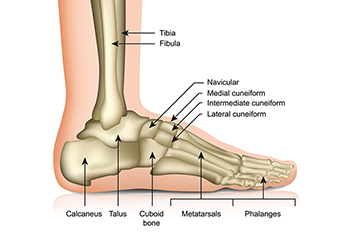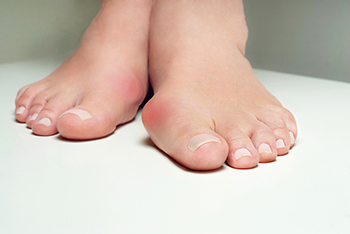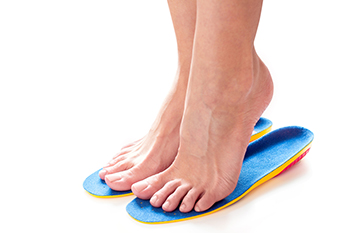Connect With Us
Blog
Items filtered by date: November 2022
How the Ankle Joint Works

One of the key joints in the body is the talocrural region, also known as the ankle joint. This joint, which connects the leg to the foot, is crucial to walking, standing, and running. The main bone in the ankle joint is the talus. Because it is not attached to any muscles, the talus is reliant on the bones surrounding it. Other bones that may be thought of as ankle bones actually belong to the lower leg or foot. These consist of the tibia and fibula of the leg, as well as the calcaneus of the heel and the navicular, which lies on top of the foot. These bones work together with the talus to allow the foot to point and flex. Another main function of the talus is to transmit force from the tibia to the calcaneus, or heel bone. Holding all these bones together is a network of ligaments. Keeping the ankle joint healthy includes wearing footwear that provides ample support and cushioning to avoid chronic ankle pain that can interfere with all your daily activities. If you have any pain or discomfort in the ankle, please visit a podiatrist for an examination and diagnosis.
Ankle pain can have many different causes and the pain may potentially be serious. If you have ankle pain, consult with one of our podiatrists from Foot Surgery Specialists of Texas. Our doctors will assess your condition and provide you with quality foot and ankle treatment.
Ankle pain is any condition that causes pain in the ankle. Due to the fact that the ankle consists of tendons, muscles, bones, and ligaments, ankle pain can come from a number of different conditions.
Causes
The most common causes of ankle pain include:
- Types of arthritis (rheumatoid, osteoarthritis, and gout)
- Ankle sprains
- Broken ankles
- Achilles tendinitis
- Achilles tendon rupture
- Stress fractures
- Tarsal tunnel syndrome
- Plantar fasciitis
Symptoms
Symptoms of ankle injury vary based upon the condition. Pain may include general pain and discomfort, swelling, aching, redness, bruising, burning or stabbing sensations, and/or loss of sensation.
Diagnosis
Due to the wide variety of potential causes of ankle pain, podiatrists will utilize a number of different methods to properly diagnose ankle pain. This can include asking for personal and family medical histories and of any recent injuries. Further diagnosis may include sensation tests, a physical examination, and potentially x-rays or other imaging tests.
Treatment
Just as the range of causes varies widely, so do treatments. Some more common treatments are rest, ice packs, keeping pressure off the foot, orthotics and braces, medication for inflammation and pain, and surgery.
If you have any questions, please feel free to contact our offices located in River Oaks and Sharpstown in Houston, TX . We offer the newest diagnostic and treatment technologies for all your foot care needs.
Effective Stretches That May Help Flat Feet

The pain that can accompany the foot condition known as flat feet may or may not affect specific people. It is described as an arch that is absent in each foot and provides shock absorption to the body. The majority of babies are born with flat feet, and the arch generally develops during the teenage years. Consequently, the arch may not develop in some people, and they can experience discomfort with flat feet as they get older. Performing specific stretches may help to strengthen the entire foot, which may help to diminish the discomfort of having flat feet. These can consist of simple stretches that are called the towel scrunch, stair heel raises, and toe extensions. Many patients enjoy practicing the towel stretch, which is done while sitting on the floor, and wrapping a towel around the feet as the toes are pointed up. Additionally, rolling the foot on a tennis ball can invoke feelings of well-being as the feet relax. If you would like additional information about effective stretches to practice with flat feet, please ask a podiatrist who can provide you with useful information.
Flatfoot is a condition many people suffer from. If you have flat feet, contact one of our podiatrists from Foot Surgery Specialists of Texas. Our doctors will treat your foot and ankle needs.
What Are Flat Feet?
Flatfoot is a condition in which the arch of the foot is depressed and the sole of the foot is almost completely in contact with the ground. About 20-30% of the population generally has flat feet because their arches never formed during growth.
Conditions & Problems:
Having flat feet makes it difficult to run or walk because of the stress placed on the ankles.
Alignment – The general alignment of your legs can be disrupted, because the ankles move inward which can cause major discomfort.
Knees – If you have complications with your knees, flat feet can be a contributor to arthritis in that area.
Symptoms
- Pain around the heel or arch area
- Trouble standing on the tip toe
- Swelling around the inside of the ankle
- Flat look to one or both feet
- Having your shoes feel uneven when worn
Treatment
If you are experiencing pain and stress on the foot you may weaken the posterior tibial tendon, which runs around the inside of the ankle.
If you have any questions please feel free to contact our offices located in River Oaks and Sharpstown in Houston, TX . We offer the newest diagnostic and treatment technologies for all your foot and ankle needs.
Types of Foot Surgery

The feet are a complicated part of our bodies. Each foot consists of 26 bones, 33 joints, and many tendons, ligaments, and muscles. A variety of conditions can affect the feet and cause discomfort, which can limit mobility. At times things happen to change the structure and mechanics of the foot and surgery may be required. Foot surgery is typically considered when more conservative approaches do not work. It is often done to reduce pain, correct a deformity, or restore foot functioning. Some examples of foot surgery include bunion surgery, hammertoe surgery, and heel surgery. If you suffer from foot pain that is not relieved by rest or a change of shoes, see a podiatrist for an evaluation and treatment. Foot surgery can usually be prevented if problems are treated in a timely manner.
Foot surgery is sometimes necessary to treat a foot ailment. To learn more, contact one of our podiatrists of Foot Surgery Specialists of Texas. Our doctors will assist you with all of your foot and ankle needs.
When Is Surgery Necessary?
Foot and ankle surgery is generally reserved for cases in which less invasive, conservative procedures have failed to alleviate the problem. Some of the cases in which surgery may be necessary include:
- Removing foot deformities like bunions and bone spurs
- Severe arthritis that has caused bone issues
- Cosmetic reconstruction
What Types of Surgery Are There?
The type of surgery you receive will depend on the nature of the problem you have. Some of the possible surgeries include:
- Bunionectomy for painful bunions
- Surgical fusion for realignment of bones
- Neuropathy decompression surgery to treat nerve damage
Benefits of Surgery
Although surgery is usually a last resort, it can provide more complete pain relief compared to non-surgical methods and may allow you to finally resume full activity.
Surgical techniques have also become increasingly sophisticated. Techniques like endoscopic surgery allow for smaller incisions and faster recovery times.
If you have any questions please feel free to contact our offices located in River Oaks and Sharpstown in Houston, TX . We offer the newest diagnostic and treatment technologies for all your foot and ankle needs.
The Best Shoes to Wear When You Have Bunions

A bunion is a bony deformity at the base of the big toe. This toe may start to point inwards towards other toes and the foot bones face out. Bunions often cause pain and swelling over the big toe joint. Reasons people get bunions are unknown, but they may be due to genetics, wearing ill-fitting shoes that are too tight, a foot injury, or arthritis. Wearing high heels can also increase the chances of one developing a bunion. Anyone can develop a bunion at any time in their life but the incidence of getting one rises by more than one-third after age 65. Also, women are more likely to suffer from this condition than men. When one has a bunion, the shape of their foot can change, and trying to find shoes that can be both comfortable and stylish can be frustrating. Wearing proper footwear for bunions is imperative to prevent worsening of the condition. Some tips for finding the right shoes include looking for shoes with a wide toe so the toes can splay rather than being pushed forward, opting for leather, suede, or elasticated materials which have more give, and making sure the widest part of the shoe corresponds to the widest part of the foot. If you suffer from a bunion, contact a podiatrist who can offer treatment options as well as more advice on selecting the best shoes.
If you are suffering from bunions, contact one of our podiatrists of Foot Surgery Specialists of Texas. Our doctors can provide the care you need to keep you pain-free and on your feet.
What Is a Bunion?
A bunion is formed of swollen tissue or an enlargement of boney growth, usually located at the base joint of the toe that connects to the foot. The swelling occurs due to the bones in the big toe shifting inward, which impacts the other toes of the foot. This causes the area around the base of the big toe to become inflamed and painful.
Why Do Bunions Form?
Genetics – Susceptibility to bunions are often hereditary
Stress on the feet – Poorly fitted and uncomfortable footwear that places stress on feet, such as heels, can worsen existing bunions
How Are Bunions Diagnosed?
Doctors often perform two tests – blood tests and x-rays – when trying to diagnose bunions, especially in the early stages of development. Blood tests help determine if the foot pain is being caused by something else, such as arthritis, while x-rays provide a clear picture of your bone structure to your doctor.
How Are Bunions Treated?
- Refrain from wearing heels or similar shoes that cause discomfort
- Select wider shoes that can provide more comfort and reduce pain
- Anti-inflammatory and pain management drugs
- Orthotics or foot inserts
- Surgery
If you have any questions, please feel free to contact our offices located in River Oaks and Sharpstown in Houston, TX . We offer the newest diagnostic and treatment technologies for all your foot care needs.
Gout Pain Can Be Managed
Foot Conditions May Be Helped by Wearing Orthotics

Many people understand that having foot pain is not normal and will often look to wearing custom-made orthotics to find relief. Orthotics are described as inserts that are worn inside the shoe that may help to correct an abnormal walking pattern. Orthotics can enable the angles of the feet to normalize as well as help make daily activities easier to complete. Additionally, they can help the patient's feet to absorb shock which may reduce pressure on existing sore spots. Orthotics are known to help correct imbalances in the feet that can affect the entire body. Some of the ways a patient may notice they qualify for orthotics include one shoe wearing out faster than the other shoe, experiencing chronic heel pain, the feet excessively pointing in or out, and the toes are not straight. If you have foot conditions that need to be corrected, please consult with a podiatrist who can determine if wearing orthotics are right for you.
If you are having discomfort in your feet and would like to try orthotics, contact one of our podiatrists from Foot Surgery Specialists of Texas. Our doctors can provide the care you need to keep you pain-free and on your feet.
What Are Orthotics?
Orthotics are inserts you can place into your shoes to help with a variety of foot problems such as flat feet or foot pain. Orthotics provide relief and comfort for minor foot and heel pain but can’t correct serious biomechanical problems in your feet.
Over-the-Counter Inserts
Orthotics come in a wide variety of over-the-counter inserts that are used to treat foot pain, heel pain, and minor problems. For example, arch supports can be inserted into your shoes to help correct overarched or flat feet, while gel insoles are often used because they provide comfort and relief from foot and heel pain by alleviating pressure.
Prescription Orthotics
If over-the-counter inserts don’t work for you or if you have a more severe foot concern, it is possible to have your podiatrist prescribe custom orthotics. These high-quality inserts are designed to treat problems such as abnormal motion, plantar fasciitis, and severe forms of heel pain. They can even be used to help patients suffering from diabetes by treating foot ulcers and painful calluses and are usually molded to your feet individually, which allows them to provide full support and comfort.
If you are experiencing minor to severe foot or heel pain, it’s recommended to speak with your podiatrist about the possibilities of using orthotics. A podiatrist can determine which type of orthotic is right for you and allow you to take the first steps towards being pain-free.
If you have any questions please contact our offices located in River Oaks and Sharpstown in Houston, TX . We offer the newest diagnostic and treatment technologies for all your foot and ankle needs.
Blog Archives
- July 2024
- June 2024
- May 2024
- April 2024
- March 2024
- February 2024
- January 2024
- December 2023
- November 2023
- October 2023
- September 2023
- August 2023
- July 2023
- June 2023
- May 2023
- April 2023
- March 2023
- February 2023
- January 2023
- December 2022
- November 2022
- October 2022
- September 2022
- August 2022
- July 2022
- June 2022
- May 2022
- April 2022
- March 2022
- February 2022
- January 2022
- December 2021
- November 2021
- October 2021
- September 2021
- August 2021
- July 2021
- June 2021
- May 2021
- April 2021
- March 2021
- February 2021
- January 2021
- December 2020
- November 2020
- October 2020
- September 2020
- August 2020
- July 2020
- June 2020
- May 2020
- April 2020
- March 2020
- February 2020
- January 2020
- December 2019
- November 2019
- October 2019

